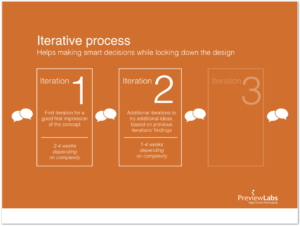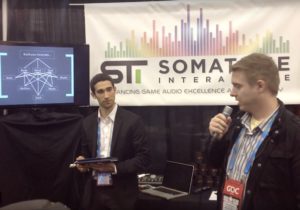As you know, PreviewLabs specializes in prototyping with game technology. Hence, people looking to work with us on a project often ask questions such as: “Do you also do the development after prototyping?”, and “How far should we take the prototyping process?”.
It is crucial to have a clean break for the source code between the prototyping phase and the production phase.

By prototyping you can to iteratively improve a concept, but it’s important to be thoughtful on where to stop iterating too (slide from our presentation deck).
How far should the prototyping process be taken?
As for the question on when the prototyping phase ends and when the production phase starts, as a rule of thumb, we recommend prototyping until you feel confident that a concept has been found which will allow you to reach your goals, and that the risk for unexpected surprises has been mitigated. That way, the production development phase can be started without major nasty surprises.
We recommend prototyping until you feel confident that a concept has been found which will allow you to reach your goals.
Once this point has been reached, it is crucial to have a clean break for the source code between the prototyping phase and the production phase. It is important to know when to stop prototyping because prototyping benefits from a different development style than the production phase:
- Because you want to gain insights to help you take crucial decisions for your project which will ultimately influence your production phase, it is important to be able to try different concepts and features quickly in the prototyping phase, and base decisions based on actual findings instead of assumptions. Therefore, prototyping benefits from a programming style that is focused on speed, and less on for instance extensibility. The software architecture needs to allow for quick changes in the core concept. The use of finite state machines and a less heavy structure with a limited number of classes can be useful – as more simple structures are usually easier to change.
- On the other hand, production quality code requires thoughtful analysis, allowing for a more elaborate architecture, with a focus on the ability to make it easier to comprehend and maintain the source code over a longer period of time. To prepare the production phase thoroughly, programmer / analysts can easily spend an entire week to define the software architecture.
How can PreviewLabs help after prototyping?

Sham Saleh and Dirk Heidecke of Skeleton Hand presenting at a booth at the Game Developers Conference after we introduced them to Somatone Interactive.
The short answer to the question on whether we also do the development after prototyping is ‘no’. However, while we like to focus on our specialization there are various ways we can help out our clients – after all, we like to do anything within our means to see them succeed, so we can brag later about our contribution to how they landed a successful game or product. For instance, if desired we advise our clients further choices and even help them find the right developer to take on the project after the prototyping phase, leveraging the various connections in our network.
Looking for a team to help Yale with the MoMba project.
This recently came up with one of our projects with Yale – MoMba, as it is time for us to help them take their project to the next level.
MoMba aims to deliver a gamified social network for first-time mothers in low-income neighborhoods. We first wrote about our prototyping work on the project on our blog 2013, and recently included it in an overview of prototypes in health research. One of the things Yale was able to achieve by prototyping with us was combining the ideas of all different stakeholders in the project, as well as running scientific research studies with around 50 participants.
Now that they’re ready to expand MoMba towards a larger audience, it’s time to switch to the production phase. As we do with all of our clients that have a need for this, we take steps to assist during this transition:
- After multiple iterations, we determine which features they want to keep.
- We document these features during the prototyping process.
- While providing support for the new developer, this desired feature set will be referenced to make sure lessons from the prototyping process are taken into account.
We are currently shortlisting developers for Yale. If your company is interested in working on the MoMba project, or if you know of a company that would be interested, please let us know.
